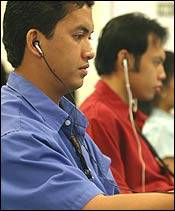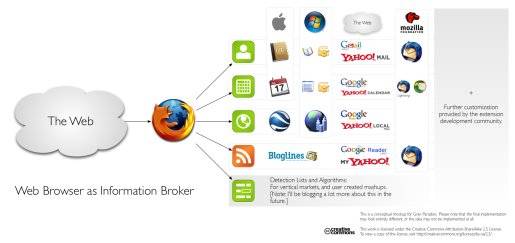By John Milan. This is the second
in a two-part series. Part 1 is
here.
What will the software solutions of tomorrow look like? They
will be forged by four powerful elements: The Internet, Open Source, Mobile Devices and
Web 2.0. We can debate the merits of each, but taken as a whole they will shape the
genetic blueprint for the successful applications of tomorrow — starting now.
Web 2.0
I had been wrestling with the merits of Web 2.0 for a while and I decided that MyBlogLog would be my case study to figure it out
(since bought by
Yahoo). It’s the vertical strip of 10 avatars found on more and more ‘social’ sites,
including to your right in Read/WriteWeb’s sidebar. There’s an odd fascination when you
see 10 strangers enter your world. In the real world I would keep my eyes straight ahead
and focus on the distant horizon. In the web 2.0 world, however, I can let my eyes wander
and – best of all – click on somebody. While it may fulfill a voyeuristic impulse, it was
hard to make a business case for this social metaphor. In fact, I had just about
concluded web 2.0 was more sizzle than substance when I went to a Christmas party…
A good friend of mine is co-owner of a medical transcription
company. He invited me to their Christmas party to see the whole operation and meet what
makes their company work – the transcriptionists. Functionally, the act of transcribing
audio files of medical dictation to digital content is what generates cash flow for the
company. But the eye-opener was the relationships the transcriptionists had cultivated
with their medical professionals. Each doctor may have an idiosyncrasy or two – a
pronunciation issue or unknown idiom – which may require a transcriptionist to ask a
question or two. One thing would lead to another and pretty soon the doctors would get to
know their assigned transcriptionists and trust them.
Social Glue
As I sauntered around the
room meeting the various transcriptionists, each of them obviously had taken ‘ownership’
of their relationship with their medical client. When I spoke to a couple of the medical
clients in attendance, it was obvious how much they appreciated the transcriptionists
assigned to their personnel. So much so, that a feature demonstrated for the next version
of their software had both doctor and transcriptionist information available – something
that looked a lot like MyBlogLog from the back row where I was sitting. As I got closer,
I could read the additional information that turned audio files and email addresses into
real people with names and biographies – maybe even a blog.

Throw broadband internet connections into every transcriptionist’s home (the company
doesn’t have a traditional office) and you have low overhead, motivated employees and
satisfied customers. Forget about proprietary file formats, exclusive contracts and
sneaky lock-ins, the single best way to keep your customers coming back is an efficient
online system and interactive relationships built on trust – on a human level. What Web
2.0 promises, in my opinion, is an online, social and economical way for people to
connect. In one sense it addresses the classic ‘service economy’, where a
doctor can work with a transcriptionist, re-imagined for a virtual world. In another
sense Web 2.0 can address a ‘collegial economy’, or peers working together.
For example, every member of a project should have presence, live up to social
expectations and have the tools to express themselves in an online environment. Project
management, with its origins in academia, has focused more on the technical aspects of
allocation, organization and scheduling. However, is there a more social endeavor in the
business world than working on a project together? Currently, people are called
‘resources’ and their working days are reduced to blue bars of various duration. And
people hate it. The philosophy of Web 2.0 dictates we turn these resources and blue bars
back into people and real life. And people will love it.
Note: Photo of Medical Transcriptionists is from
Wikipedia
The Missing Link
It wouldn’t be mutation and evolution without a missing link. However, instead of
finding the link from our past, we will predict it for our future. Like a Babel Fish
crawling from a sea of data, we will begin seeing applications whose main purpose is to
translate and transpose data from one system to another. While most current software
applications can import from several formats and write to a few, they will soon be
overwhelmed by the permutations – as distribution, portability and specialization
increase the options.
Perhaps we just caught the first glimpse of the missing link with Mozilla’s
announcement that Firefox
will support Microformats. It may be a little awkward at first, as it sounds like
specific extensions (see
comment #7) will be required for applications to interact with the microformats, but
Firefox has made its move toward the beach. As Mozilla’s Alex Faaborg correctly
noted:
“… the difficult part of microformat detection is not parsing the data, it is
dealing with the wide range of APIs for all of the different applications on all of the
different platforms that can consume this data.”
Firefox 3 as Information Broker; diagram
by Mozilla

If Mozilla can solve this by elegance or by sheer people power, and make this data
accessible, Firefox might just begin to encroach on Outlook in addition to Internet
Explorer. Call it the inbox for the next generation.
Let’s Make a Deal
The internet is delivering more and more useful, utilitarian options. People will
always demand more access to their data and more integration with their apps. Mobile
Devices will drive specialization, slicing and dicing rich data for their specific needs.
And Babel Fish applications will connect this cacophony into coherence. The result? The
single minded, all-encompassing applications of today will begin dying off in favor of
multi-celled, specialized solutions. As soon as data begins to flow freely from app to
app, as Joel Spolsky
noted, the size of the ecosystem is no longer a barrier (or lock-in) – instead the
efficacy of the solution becomes the desired characteristic for survival.
In fact, the best solution may no longer be under the purview of a single company. It
may actually grow, like some genetic algorithm, after several iterations of various
combinations. Companies may end up spending more time negotiating all the possibilities,
than making up new proprietary formats, as agreements and pacts will become the new means
of customer lock-ins. Why did the
Motorola iTunes phone fail and the new iPhone take more than a year to appear? It wasn’t
just the technology.
The coming agreements, pacts and understandings among corporations will need a word
beyond byzantine to describe them. But if you lack a legal team and have customers
chomping at the bit for solutions, you have more opportunity than ever before to cut your
own deal and get a piece of the action. You could try to create all the pieces for the
next generation solutions (internet connectivity, open source data interoperability,
mobility and usability), but it will be impractical for even large companies to create
something compelling. Instead, it will be combinations of best of breed
technology.
And what trait will the eventual winners in this brave new world share? The solutions
that can hone their data requirements, move results from system to system, use the best
form factor for the job and still keep it on a human level.










